Introduction
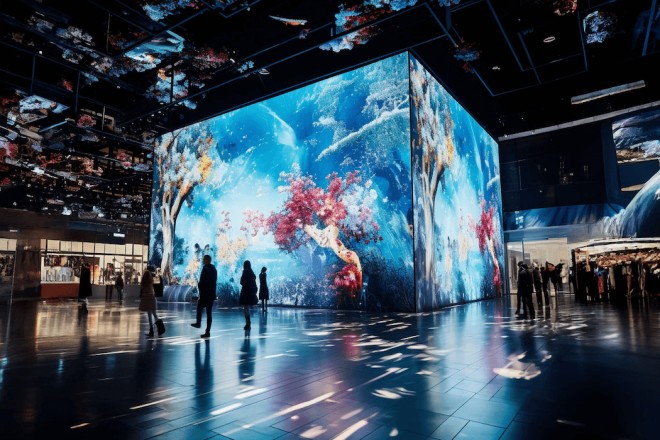
Entering a new era of visual expositions, Écrans d'affichage LED are redefining the boundaries of exhibitions and the experience of audiences with a revolutionary attitude.
From static artworks to dynamic image displays, from monotonous text information to colorful multimedia content, LED display screens are becoming an indispensable bridge between creators and audiences with their excellent display effects and unlimited creative potential.
This article goes straight to the core and will deeply analyze the practical application and unique advantages of LED display screens in visual exhibitions, revealing to you how this technology reshapes exhibition spaces and enhances audience experience, as well as the innovative power and future trends behind it.
1. Advantages of LED display screens in visual exhibitions
The application of LED display screens in exhibitions has many significant advantages, which not only enhance the visual effects of the exhibition but also enhance the audience’s participation and experience. The following is a detailed explanation of the advantages of LED display screens in exhibitions:
1). Excellent display effects and visual impact
- Haut résolution and delicate picture quality:
LED display screens use advanced pixel pitch technology to present extremely clear and delicate images and texts.
Whether it is displaying exquisite product pictures, complex charts, or playing high-definition videos, it can be done in detail to ensure that the audience can receive information clearly and accurately.
- Wide color gamut and high contrast:
LED display screens have a wide color gamut and high contrast, which can show bright and realistic colors. This makes the exhibits in the exhibition more vivid and appealing, which helps to attract the attention of the audience.
- Large size and seamless splicing:
LED display screens can achieve large-size seamless splicing to form a huge screen wall or a special-shaped display area. This large-size display method can create a shocking visual effect and enhance the attractiveness of the exhibition.
2). Flexible application and creative display
- Diverse display forms:
LED display screens support display content in multiple formats, including pictures, videos, animations, text, etc. This makes the display forms in the exhibition more diverse and can meet different exhibits and display needs.
- Dynamic update and real-time interaction:
LED display screens can update the display content in real time to ensure that the audience can get the latest exhibition information. At the same time, some LED display screens also support interactive functions, and the audience can interact by touching the screen or other means, which increases the fun and interactivity of the exhibition.
- Custom design:
LED display screens can be customized according to the theme and style of the exhibition, including screen shape, color, border, etc. This personalized design makes the display in the exhibition more unique and eye-catching.
3). Strong adaptability and high stability
- S'adapter à divers environnements :
LED display screens have the characteristics of high brightness and adjustable luminosité, and can adapt to various light environments. Whether it is a bright indoor environment or an outdoor environment, LED display screens can ensure good display effects.
- Haute stabilité :
LED display screens use advanced manufacturing processes and materials, and have high stability and reliability. During the exhibition, even if it runs for a long time, there will be no failure or performance degradation, ensuring the smooth progress of the exhibition.
4). Economic benefits
- Significant economic benefits:
Although the initial investment in LED display screens is large, their excellent display effect, flexible application methods, and long-term economic benefits make them a cost-effective choice for the exhibition.
Through the display of LED display screens, the exhibition can attract more audiences and potential customers and increase the popularity and influence of the exhibition.
2. Application scenarios of LED display screens in visual exhibitions
As one of the core technologies of modern visual exhibitions, LED display screens have a variety of application scenarios that bring unprecedented immersive experiences and interactivity to the audience.
The following are several main application scenarios of LED display screens in visual exhibitions:
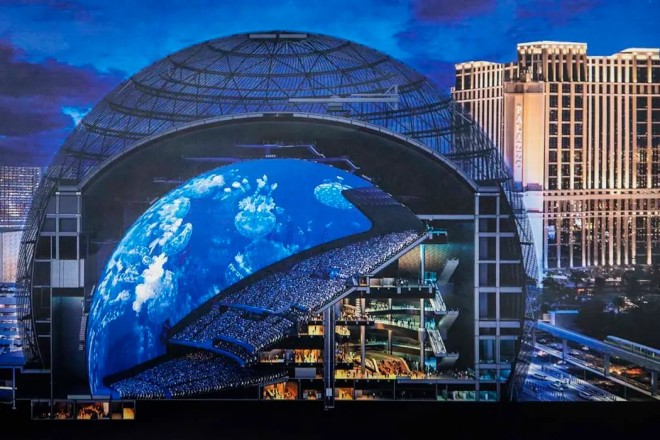
1). Immersive experience space
1.1). 360-degree ring screen and ball screen theater
- Scénario d'application :
In visual exhibitions, 360-degree ring screens and ball screen theaters use LED display screens to surround the audience to form a closed visual space. This design makes the audience feel as if they are in a movie or virtual scene and get a full range of visual experience.
- Avantages :
Ring screen and ball screen theater not only provide shocking visual effects but also enhance the audience’s sense of immersion and substitution through multi-sensory stimulation such as sound and light.
1.2). Ground interactive écran LED au sol
- Scénario d'application :
Ground interactive LED floor screen is usually installed on the ground of the exhibition space, and it can achieve real-time interaction with the screen by sensing the audience’s walking, jumping and other actions.
- Avantages :
This design not only increases the fun of the exhibition but also allows the audience to have a deeper understanding of the exhibits and exhibition themes through interactive games, simulated scenes, and other methods.
2). Interactive art installation
2.1). Motion capture and real-time interaction
- Scénario d'application :
Motion capture technology captures the audience’s movements through cameras or sensors and converts them into digital signals, which are fed back to the LED display in real time.
This technology can be applied to various art installations, such as dance performances, light and shadow interactions, etc.
- Avantages :
Motion capture and real-time interactive technology enable the audience to become part of the exhibition, interact with exhibits and exhibition spaces, and enhance the participation and interactivity of the exhibition.
2.2). Combination of AI technology and artistic creation
- Scénarios d'application :
AI technology can be applied to all aspects of artistic creation, including design, production, and display. On LED display screens, AI technology can generate various unique visual effects, such as dynamic patterns, light and shadow changes, etc.
- Avantages :
The combination of AI technology and artistic creation brings more creativity and possibilities to the exhibition, making the exhibition content more diverse while also providing the audience with a more unique visual experience.
3). Exhibition information release
3.1). Real-time traffic and weather information
- Scénarios d'application :
In large-scale exhibitions or events, real-time traffic and weather information are crucial for the audience. LED display screens can display this information in real time to help the audience plan travel routes and schedule activities.
- Avantages :
Displaying real-time information through LED display screens not only improves the efficiency of information dissemination but also allows the audience to obtain the latest traffic and weather dynamics while visiting the exhibition, ensuring the smooth progress of the event.
3.2). Exposition guide and educational information
- Scénario d'application :
LED display screens can display exhibition guide maps, exhibit introductions, educational information, and other content to help visitors better understand the exhibition content and background knowledge.
- Avantages :
Displaying guides and educational information through LED display screens not only improves the visitor’s visit efficiency but also allows the audience to learn more knowledge and culture while appreciating the exhibits.
In addition, LED display screens can also provide personalized guide services according to the needs and interests of the audience to enhance the audience’s visit experience.
3. How LED display screens can deeply enhance the visual exhibition experience
The application of LED display screens in visual exhibitions is like opening the door to the future for the exhibition world.
It not only makes the exhibition content more vivid and three-dimensional but also allows the audience to enjoy an unprecedented exhibition experience in immersion and interaction. Below, we will discuss in more detail how LED display screens can deeply enhance the visual exhibition experience.
1). Enhance visual impact: Let the exhibition content “jump onto the screen.”
- Exquisite picture quality and accurate presentation:
LED display screens accurately present every detail of the exhibition content with their high resolution. Whether it is delicate brush lines or rich color levels, they can be perfectly restored on LED display screens.
This improvement in picture quality makes the exhibition content more vivid and realistic, as if it “jumps onto the screen,” greatly enhancing the visual impact.
- Dynamic effects, fascinating:
In addition to static displays, LED displays also support rich dynamic effects, such as gradients, flashing, animations, etc.
These dynamic effects not only make the exhibition content more vivid and interesting, but also attract the attention of the audience and guide them to explore the exhibition content in depth.
2). Provide interactive experience: make the exhibition “alive”
- Touch interaction, free as you like:
Some LED displays support touch function, and the audience can get information, participate in games or perform other interactive operations by touching the screen.
This touch interaction method breaks the passive viewing mode of traditional exhibitions, allowing the audience to become participants in the exhibition and make the exhibition “alive”.
- Motion capture, real-time feedback:
Using advanced motion capture technology, the LED display can capture the audience’s movements in real time and provide corresponding feedback based on the movements.
This real-time interaction not only increases the fun of the exhibition but also allows the audience to have a deeper understanding of the exhibits and exhibition themes during the interaction.
3). Create an immersive environment: Let the audience “be there”
- Surround layout, closed visual space:
Through the surround layout, the LED display can form a closed visual space so that the audience seems to be in the exhibition content.
This layout method can create a strong sense of immersion so that the audience seems to be “immersive” and experience the exhibition content more deeply.
- Multi-sensory stimulation, all-round experience:
In addition to visual stimulation, LED display screens can also be combined with other sensory stimulations, such as sound, light, smell, etc.
This multi-sensory stimulation method can further enhance the immersive experience, allowing the audience to fully experience the exhibition content in multiple dimensions, such as vision, hearing, and smell.
4). Expand the expression form of exhibition content: Make the exhibition “colorful.”
- Diversified display formats to meet needs:
LED display screens support display content in multiple formats, including pictures, videos, animations, text, etc. This diversified display format makes the exhibition content more colorful and can meet the needs and interests of different audiences.
- Real-time update, keep fresh:
LED display screens can update the display content in real time to ensure that the audience can get the latest information. This real-time update capability not only keeps the exhibition content fresh but also allows the audience to constantly discover new surprises during the visit.
4. Innovative application of LED display screens in exhibition design
In exhibition design, LED display screens are no longer just a simple information dissemination tool but have become a key element in creating unique visual experiences and interactive effects.
The following are several innovative applications of LED display screens in exhibition design, designed to help you understand its unique charm and application potential more deeply.
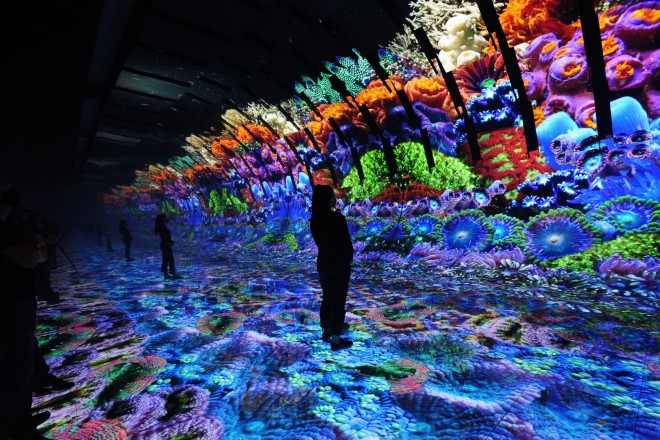
1). Special-shaped LED display screens: Breaking the rules and shaping the unique visual focus
1.1). Definition and characteristics:
Special-shaped LED display screens refer to those whose shapes are not limited to traditional rectangles or squares.
They can be customized into various unique shapes, such as circles, arcs, triangles, diamonds, etc., according to the specific needs and design ideas of the exhibition space.
1.2). Application scenarios:
Focus display: Use special-shaped LED display screens as focal displays at the entrance, central area, or next to important exhibits of the exhibition to attract the attention of the audience.
Space decoration: Take advantage of the flexibility of special-shaped LED display screens and integrate them into the decoration design of the exhibition space, such as wall decoration, ceiling decoration, etc., to create a unique visual effect.
1.3). Advantages:
Strong customization: It can be customized according to the specific size and shape of the exhibition space to ensure perfect integration with the exhibition environment.
Visual impact: The unique shape and dynamic effects can produce a strong visual impact and enhance the attractiveness of the exhibition.
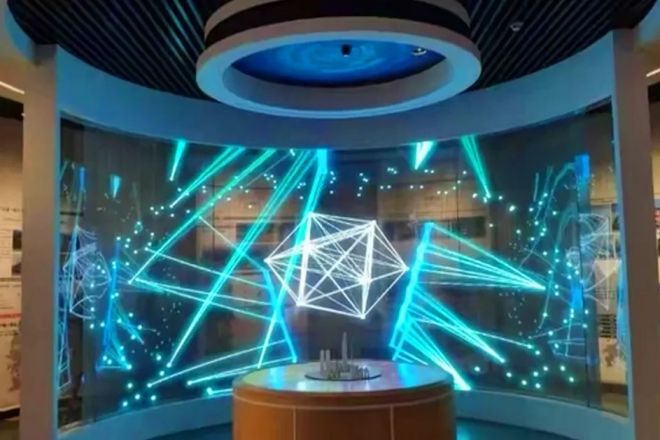
2). Affichage LED transparent: Integrate reality and virtuality to create unlimited possibilities
2.1). Definition and characteristics:
A transparent LED display is a transparent LED display whose screen is partially or entirely made of transparent materials, and the objects behind it can be seen through the screen.
2.2). Application scenarios:
Background display: In the window, wall or booth of the exhibition, use transparent LED display as background display, and display the exhibits and the environment behind at the same time to create a unique visual effect.
Interactive experience: Combined with AR (augmented reality) technology, the audience can interact with virtual content through the transparent LED display, such as touching the screen to trigger dynamic effects.
2.3). Advantages:
Spatial fusion: The transparency of the transparent LED display blurs the boundary between virtual and reality, creating a more natural and harmonious visual effect.
Interactivity: Combined with interactive technology, it can create a rich interactive experience and enhance the audience’s participation and experience.
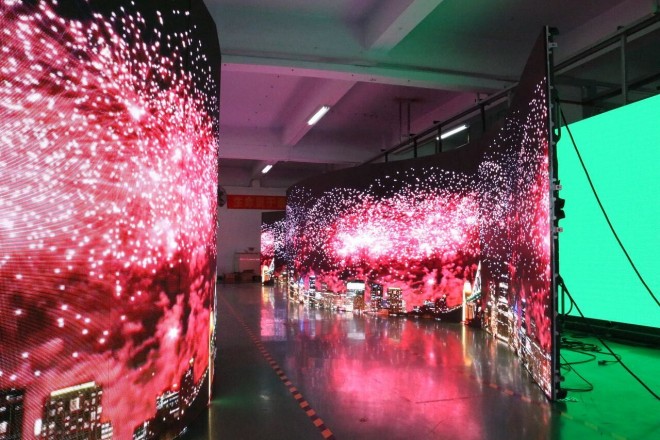
3). Écran LED flexible: Flexible and changeable, shaping unlimited creativity
3.1). Definition and characteristics:
Flexible LED display is a kind of LED display that can be bent and folded, and its screen material has good flexibility and plasticity.
3.2). Application scenarios:
Curved display: Use flexible LED display screens for curved display on the walls, columns, or ceilings of the exhibition to create a unique visual effect.
Dynamic sculpture: Combine artistic creativity to make flexible LED display screens into dynamic sculptures as one of the highlights of the exhibition.
3.3). Advantages:
Flexibility: The flexibility of flexible LED display screens allows it to adapt to various complex spatial layouts and shape requirements.
Creativity: Combining artistic creativity and technical means can create unique visual effects and interactive experiences.
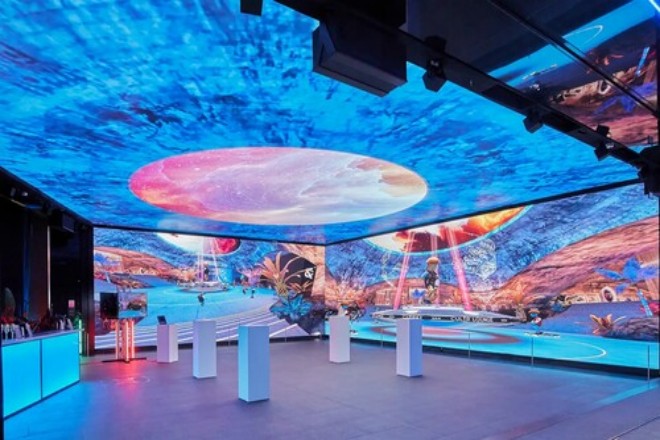
4). LED floor screens and skylight screens: Create an immersive experience and improve the quality of exhibitions
4.1). Floor LED screens:
Application scenarios: Use LED floor screens for interactive display in the ground area of the exhibition. The audience can trigger dynamic effects such as changing colors, patterns or sounds by stepping on the screen.
Advantages: Increase the interactivity and fun of the exhibition and enhance the audience’s participation and experience.
4.2). Skylight screen:
Application scenarios: Use skylight screens for large-scale display at the top or high altitude of the exhibition. It can play videos, animations or static images to create a shocking visual effect.
Advantages: It provides a wide viewing angle and stunning visual effects, enhancing the immersion and appeal of the exhibition.
5. Case analysis of LED display screens in visual exhibitions
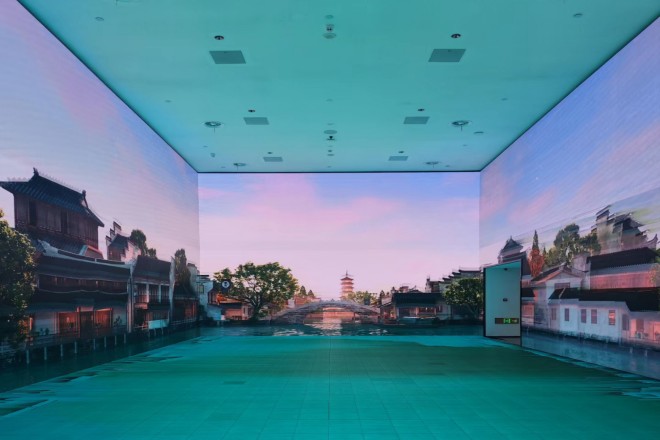
1). The “Dream Corridor” of Wuzhen World Internet Science and Technology Museum
Imagine that you walk into the World Internet Science and Technology Museum in Wuzhen and pass through a special corridor. The sides and top of this corridor are covered with LED display screens. These screens are like windows, but they do not show the scenery outside, but various wonderful pictures and information about the Internet.
As you walk slowly, the content on the screen changes with your pace. Sometimes, you will see the origin and development of the Internet; sometimes, you seem to be in a wonderful world composed of code and data. These pictures are not only colorful but also very vivid as if you are really swimming in the ocean of the Internet.
This is the clever use of LED display screens in the Wuzhen World Internet Science and Technology Museum. It creates an immersive environment, allowing the audience to deeply feel the charm of the Internet while enjoying the exhibition.
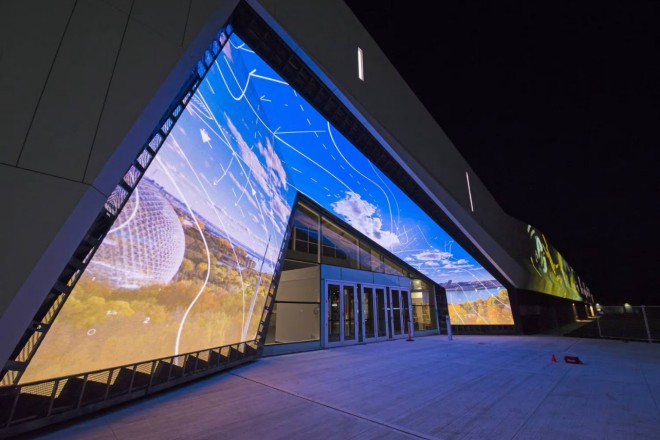
2). The “cool coat” of the Canadian Science and Technology Museum
Let’s take a look at the Canadian Science and Technology Musée. One special thing about this museum is that it has a very modern look, and this is largely due to the application of LED displays.
Many large LED displays are installed on the exterior walls of the museum. These screens are like the “eyes” of the museum, showing the latest developments and exhibition information of the museum to the outside world at all times.
During the day, these screens may not be very conspicuous in the sun, but at night, they light up and emit colorful light. The content on the screen can be small knowledge about science and technology, or it can be a preview of an upcoming exhibition. In this way, not only does it make the museum more eye-catching at night, but it also attracts more tourists to visit.
More importantly, the content of these LED displays can be updated in real time. This means that the museum can adjust the content on the screen at any time according to different exhibitions and activities so that the audience can have a general understanding of the exhibition before visiting.
So, you see, the application of LED displays in visual exhibitions is very extensive. It can not only create a vivid and interesting exhibition environment but also enhance the modernization level and attractiveness of the exhibition.
Conclusion
In summary, the application of LED display technology in visual exhibitions has not only greatly enriched the form and content of the exhibition but also improved the audience’s viewing experience and information reception efficiency.
With its unique charm, LED display has become a bridge connecting the past and the future, reality and dreams.
Enfin, si vous souhaitez en savoir plus sur les écrans LED, veuillez nous contacter.
